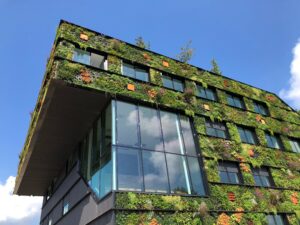5 Sustainability and Health Benefits of Living Buildings
 Living buildings are a breath of fresh air in any city. They’re a sustainable alternative to traditional buildings and can positively affect the people living where they’re built.
Living buildings are a breath of fresh air in any city. They’re a sustainable alternative to traditional buildings and can positively affect the people living where they’re built.
Living buildings incorporate plants into architecture. Plant life can be on walls, roofs or windows, and some structures consist entirely of sustainable plant alternatives. The goal is to engineer something eco-friendly to create and maintain. People react positively to nature, and living buildings combine construction and the health benefits of living outdoors.
1. Helps the Climate
Cities use a lot of energy and reflect light, and all that concrete, metal and glass gets hot. This leads to urban heat islands. The city creates heat, and the attempt to cool things down uses energy, creating more heat.
Cities become heat islands because they contain material that absorbs warmth from the sun. Adding greenery to buildings helps solve this issue by decreasing air temperature and providing shade.
2. Saves Resources
The materials used in living buildings can save resources like water and oxygen. For example, bamboo produces over 35% more oxygen than trees. Bamboo is effective since it grows quickly and is strong and light. Green materials like this are great, sustainable alternatives because they save resources.
Additionally, they conserve water and prevent drought. The plants hold water for long periods and slowly release the excess. Rainfall is preserved instead of washing down drains, giving cities an additional water source. This also means they spend fewer resources watering the plants.
3. Provides an Ecosystem
Stormwater is a significant problem in cities because concrete doesn’t soak up rainfall. Plus, pollution is a side effect of getting stormwater out of the city — the runoff is the main cause of water quality issues in the United States. Any trash, waste or chemicals on the ground are washed down drains directly into waterways. Living buildings absorb stormwater and act as barriers against flooding, which reduces pollution.
When plants absorb water — like when living roofs capture stormwater — they’re motivated to grow. Instead of turning into puddles on the sidewalk, the rain strengthens the architecture. Plus, rainwater attracts animals living in the city. Living buildings inspire a diverse ecosystem by giving birds and bugs a place to live out of the way of people.
4. Reduces Stress
City dwellers usually live alongside a lot more gray than green. In the United States, the average person spends around 90% of their time inside, surrounded by brick and concrete. This statistic becomes even more surprising when you consider plants can calm you and reduce stress. Houseplants increase happiness, and buildings covered in plants could decrease even more tension.
5. Makes for Easy Maintenance
Structures designed with sustainability in mind are often easier to maintain because they’re built to last. The specific benefit of living buildings exists because architects and engineers must consider the plants.
The building must have added protection against weight, leaks and wind to ensure it’s structurally safe. A living roof will likely last double the time of a regular one. The extra care that goes into them when they’re first built ensures they’ll stay stronger for longer. It also makes future maintenance easier.
They can also fix themselves. Maintenance workers must repair cracked concrete or broken wooden beams, but living structures automatically improve themselves through new growth.
For example, a live trellis will slowly fix itself if damaged, while a metal model will stay broken. Self-repairing structures allow officials to focus on things more important than repairing outdated infrastructure, helping cities save time and money.
Live Better in Living Buildings
Nature positively impacts people’s health and well-being. Beyond that, including the outdoors in cities reduces human impact on climate change, improving the local ecosystem and environment. People have long seen cities as the opposite of nature — maybe it is time for that to change.


Sorry, the comment form is closed at this time.